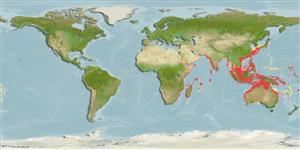Common names from other countries
Environment: milieu / climate zone / depth range / distribution range
Écologie
; profondeur 5 - 252 m (Ref. 348), usually 15 - 150 m (Ref. 348). Tropical
Distribution
Pays | Zones FAO | Écosystèmes | Occurrences | Introductions
Indo-West Pacific: from northwest Indian Ocean, to Papua New Guinea and Loyalty Islands; north to Japan and south to southern New South Wales.
Length at first maturity / Taille / Poids / Âge
Maturity: Lm ? range ? - ? cm Max length : 10.0 cm TL mâle / non sexé; (Ref. 348); common length : 6.0 cm TL mâle / non sexé; (Ref. 348)
Description synthétique
Morphologie
Shell relatively thin but solid, inflated, inequilateral, roughly quadrate to subtrigonal in shape, with a rounded umbono-ventral keel and an obliquely truncated posterior margin; slightly inequivalve, left valve somewhat projecting beyond right along posterior and ventral margins. Umbones subcentral, prominent, on top of a well-developed trigonal cardinal area which is engraved by oblique, chevron-shaped grooves and covered with a black external ligament. Outer sculpture of numerous radial riblets and concentric threads forming a fine reticulation. Periostracum conspicuous, velvety. Hinge elongate, straightish dorsally and weakly arched ventrally, bearing a series of transverse, diverging outward teeth, and rather long, subhorizontal teeth at both ends, at least in adults. Interior of shell porcelaneous. Two subequal adductor muscle scars; inner margin of posterior scar on a projecting shelf. Pallial line without a sinus. Internal margins with a fine crenulation becoming obsolete in old individuals. Colour: outside of shell purple tan, with a yellowish periostracum. Inner side white, more or less strongly tinged with dark reddish brown posteriorly.
On sandy to muddy bottoms offshore (Ref. 348).
Life cycle and mating behavior
Maturité | Reproduction | Frai | Œufs | Fécondité | Larves
Members of the class Bivalvia are mostly gonochoric, some are protandric hermaphrodites. Life cycle: Embryos develop into free-swimming trocophore larvae, succeeded by the bivalve veliger, resembling a miniature clam.
Poutiers, J.M. 1998. (Ref. 348)
Statut dans la liste rouge de l'IUCN (Ref. 130435)
statut CITES (Ref. 108899)
Not Evaluated
Not Evaluated
Utilisations par l'homme
| FishSource |
Outils
Plus d'informations
Taille/ÂgeCroissanceLongueur-poidsLongueur-longueurMorphologieLarvesAbondance
Sources Internet
Estimates based on models
Preferred temperature
(Ref.
115969): 20.7 - 29, mean 27.7 (based on 3394 cells).
Vulnérabilité
Low vulnerability (10 of 100).
Catégorie de prix
Unknown.
